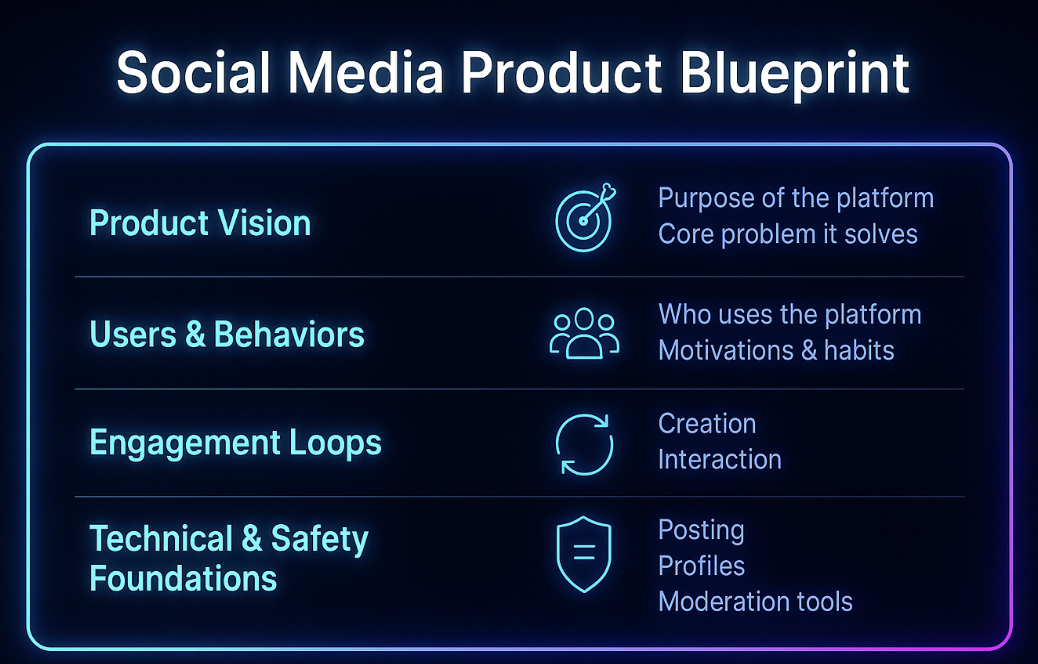Developing a social media platform today is not just about coding features or designing sleek interfaces. These products operate in one of the most competitive digital categories, where user expectations are shaped by global giants and where engagement depends on psychological triggers, frictionless interactions, and constant content flow. Before a single design file is drafted or a technical architecture is mapped, there is one stage that shapes everything that follows: business analysis.
Business analysis is the structured foundation that turns the idea of a social application into a clear, defined, and buildable product concept. It ensures that business goals, user expectations, and technical realities are aligned long before development begins. And because social platforms rely on intricate engagement patterns, fast response times, and complex moderation requirements, the BA work behind them is more demanding than in many other product classes.
This article breaks down what business analysis actually means in social media product development, why it determines the quality and trajectory of the entire build, and the exact steps, metrics, and deliverables a BA produces before development formally starts.
What Business Analysis Means in Social Media Product Development
In social media development, business analysis is the upfront process that organizes the product’s structure, features, and user interactions before any design or coding begins. It is not about deciding whether the product should exist; it is about defining what the product must do, how it should work, and what conditions it must meet to support sustainable user interactions.

In a social platform, business analysis focuses on:
- Translating high-level goals into functional logic.
This means turning broad product intentions into clear, structured definitions of how features should work and how users are expected to interact with them.
- Understanding user behavior and interaction patterns.
Social apps succeed based on how users create, share, and return.
- Mapping the engagement loops that drive activity.
These flows must be defined before design, otherwise UX becomes guesswork.
- Structuring requirements clearly and unambiguously.
Ambiguous or incomplete requirements are among the top causes of rework in social media projects.
- Identifying constraints and dependencies.
Social platforms rely heavily on real-time operations, multimedia storage, privacy controls, and content safety mechanisms.
- Clarifying priorities.
Not every feature is needed for an MVP, and not every founder’s idea aligns with user needs.
In simple terms:
BA is the stage where the social media platform becomes a real product on paper, long before it becomes one in code.
Why Social Media Apps Fail (and How BA Prevents It)
Many social media apps fail long before they gain traction, and the reason is almost always weak foundations. When requirements, engagement logic, and user flows are not clearly defined early, development becomes guesswork. Business analysis prevents these early failures by giving structure, clarity, and direction to the product before a single feature is built.
- Vague or Overly Broad Product Vision
Many social apps begin with general ideas about “community” or “connection” but lack specific definitions of how users will actually interact.
BA prevents this by translating broad ideas into concrete use cases, functional logic, and measurable objectives, giving the product a clear purpose.
- Unclear User Journeys and Engagement Flows
Social platforms rely on predictable loops: posting, reacting, discovering content, and returning. When these flows are not mapped early, the experience feels disconnected or unmotivating.
BA visualizes these flows and defines the structure behind every interaction, ensuring the platform behaves as a cohesive system.
- Feature Flooding and Lack of Prioritization
Founders often want too many features too early, slowing development and diluting the MVP.
BA uses prioritization frameworks to identify essential features, sequence upcoming releases, and keep the initial scope manageable.
- Missing Moderation and Safety Logic
Reporting, blocking, content guidelines, and review workflows are foundational, not optional. Without them, platforms quickly become unsafe or unmanageable.
BA integrates moderation and safety requirements into the product from the beginning, defining flows and rules that protect users.
- Misaligned Technical Expectations
Social platforms depend on scalability, speed, and data-heavy interactions. When technical expectations aren’t clarified early, engineering teams face costly rework.
BA defines technical assumptions and constraints upfront, ensuring the product is planned around realistic performance needs.
In essence, social media apps fail when they move into development without clarity.
Business analysis provides that clarity, aligning business goals, user behavior, and technical feasibility before development begins.
Practical BA Framework for Social Media Development: Step-by-Step
Business analysis shapes a social platform long before development begins. The goal is to turn a broad concept into a structured foundation that designers and engineers can execute without ambiguity. Below is the streamlined framework a BA follows when preparing a social media product for development.
Step 1: Establish Objectives and Core Functionality
The BA starts by defining the platform’s purpose and the functional pillars that support it. This means turning general intentions like “content sharing” or “community building” into concrete use cases and early functional areas. The first step also clarifies what belongs in the MVP and what can be postponed, giving every team a grounded starting point.
Key outcomes include: a clear product purpose, essential use cases, and an initial MVP feature outline.
Step 2: Understand Users and Their Interaction Patterns
Social platforms depend on behavior, not just demographics. The BA studies how users create, consume, and respond to content, what motivates them, and what causes friction. These insights guide UX decisions, feature logic, and the platform’s overall tone.
Typical insights cover: motivations, preferred content types, safety expectations, and barriers that may affect engagement.
Step 3: Define Engagement Loops and Social Behavior Flows
Engagement loops are the engines of social platforms. The BA maps how users move through posting, reacting, discovering new content, and returning to the app. They also define moderation flows, which are essential for safety and trust. These loops are visualized as journey maps or state diagrams, giving the entire team a shared understanding of how the platform behaves.
Primary loops include: creation, interaction, discovery, return, and moderation.
Step 4: Form Functional Requirements
Once behavior and loops are defined, the BA translates them into specific functional rules. This includes how posting works, how comments behave, how profiles are structured, how messaging flows, and what permissions or visibility rules apply. Functional requirements remove ambiguity and ensure each feature behaves predictably.
Step 5: Form Non-Functional Requirements
Social platforms demand strong performance, scalability, and security. The BA clarifies expectations for feed-loading speed, media upload constraints, messaging latency, user data protection, moderation tool uptime, and other non-functional requirements. These requirements guide architectural decisions and prevent costly redesigns later.
Step 6: Outline Technical Preconditions and Dependencies
The BA documents technical expectations, including authentication requirements, real-time communication requirements, media storage assumptions, analytics requirements, and integrations. They also identify module dependencies to ensure development is sequenced logically.
Step 7: Define Risks, Moderation, and Compliance Rules
Safety and compliance are foundational in social media. The BA defines reporting flows, moderation steps, account restriction rules, content guidelines, spam mitigation logic, and legal obligations. This ensures the platform launches with consistent, enforceable community standards.
Step 8: Map Monetization Logic and Feature Dependencies
Finally, the BA clarifies how monetization fits into user flows, whether through ads, subscriptions, or creator tools. They document how paid features differ from free ones, what data is needed, and how monetization interacts with engagement.
Key Metrics Every BA Tracks in Social Media Development
Even before a social platform launches, a business analyst needs to understand a few simple, foundational metrics that shape how the product should work. These aren’t precise numbers yet: they’re directional indicators that help define requirements, plan features, and set expectations for the technical team.
Many of these indicators mirror the standard engagement metrics: most readers will instantly recognize these because they’re the same metrics used by every major social network.
- New user activation
How many users get through onboarding and reach their first key action (creating a post, following someone, liking content). This influences how simple and intuitive early flows must be.
- Daily usage frequency
How often users are expected to open the app each day. This guides notification logic, feed behavior, and what “fresh content” means.
- Session length
How long a typical visit might last. This affects decisions about feed loading, scrolling performance, and how much content needs to be ready at any moment.
- Engagement depth
How many actions users take per session — likes, comments, shares, saves. This shapes interaction rules and the real-time behavior of the platform.
- Content volume
How much content users are likely to upload. Even rough estimates help determine storage needs, media limits, and upload or compression rules.
- Peak activity times
When users are most active. This affects performance expectations and helps anticipate potential technical bottlenecks.
- Early retention
How many users come back after their first day or first week. Even modeled estimates help BAs prioritize the features that support return behavior.

Conclusion
Business analysis provides the social media product with its structure long before design or development begins. It defines how users will interact with content, what the platform must deliver from the first session, and which technical or safety considerations must be in place to ensure the experience feels consistent. With this clarity, teams avoid stepping into development with vague assumptions, scattered ideas, or features that pull the product in conflicting directions.
By mapping user journeys, shaping engagement loops, documenting feature behavior, outlining performance needs, and identifying risks, BA turns abstract concepts into a clear product blueprint. These steps also produce the practical outputs development relies on — from personas and journey maps to requirements, moderation rules, and early technical assumptions — creating alignment across design, engineering, and business teams.
When paired with simple, universal metrics like activation, daily usage, session length, content volume, and early retention, business analysis helps shape platforms around real user behavior rather than guesswork. This structured approach consistently strengthens outcomes for social and community-driven products, and LenGreo uses it to guide teams toward decisions that support engagement, scalability, and long-term product momentum from the very beginning.









